As the progeny of two economists, my children have been the subject of all manner of incentive-based experiments. Contracts trading hockey tickets for good grades, or computer time for household chores are examples of things we have employed over the years to align interests and steer behavior in the right direction.
The West is using a similar strategy in its dealings with Vladimir Putin. Economic consequences are being used as rewards and deterrents, in the hope that the Russian forces camped on the Ukraine border will stand down. Sanctions have been implemented on both sides that limit the movement of money, people and products. This isn’t ideal, but as one observer noted: better a Cold War than a hot war.
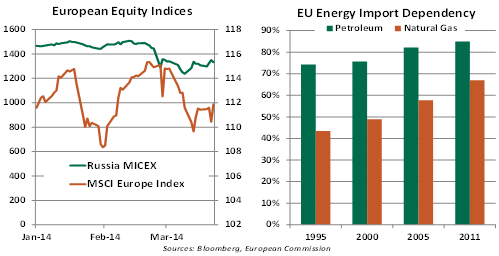
The situation has already taken a substantial toll on Russian equity markets, while those in Western Europe have held up pretty well. Reports suggest that both Russian and international money are leaving the country for safer havens. The loss of foreign investment and the cost in wealth to Russian shareholders could be very damaging to the Russian economy.
Russia’s biggest potential lever with the West is the threat of limited natural gas supply. Western Europe has become much more reliant on imported natural gas over the past two decades. And Gazprom provides about 30% of the natural gas used by the European Union (EU).
In the short term, spring is coming and European energy reserves are reasonably high. So it is not clear that Russian restrictions will have a deep impact over the coming months. And in the long term, Mr. Putin’s use of natural gas as a bargaining chip may backfire.
First, energy exports make a lot of money for Russia, and bring in hard currency. Sales of oil and natural gas to the EU account for 63% of Russia’s foreign energy sales, with an estimated value of about $230 billion. A significant decline in this activity could send Russia into recession.

Second, energy producers face a difficult balancing act as they try to maximize revenue and leverage. Allowing fuel to flow too freely hurts both objectives in the short run, but constraining output may have the same negative effects in the long run. Expensive or irregular supply from a given source motivates clients to seek or develop alternatives.
In the case of natural gas, there are some intriguing options, but all of them will take time to develop. American production of gas has skyrocketed over the past eight years, and U.S. exports have grown geometrically. But almost all of this travels north to Canada or south to Mexico through pipelines.
To reach Europe, natural gas would have to be compressed or liquefied. Handling these potentially volatile states requires specially-equipped terminals at ports on both ends, and facilities to distribute the gas once it arrives. This would take significant investments in infrastructure, but the strategic and economic returns to these investments have clearly risen in the last two months.
Discussion is underway in Washington to facilitate steps in this direction. Some legislators would prefer to keep the American gas bounty at home to hold down prices to domestic consumers and promote U.S. manufacturing. But the strategic value of energy export, to say nothing of the potential profits, will be a very persuasive part of the discussion.
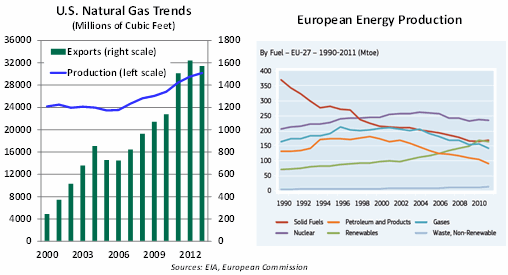
The strategic threat of supply interruption could also prompt Europe to revisit its energy strategy, which has stressed reductions in nuclear power and coal in favor of renewable sources. There are thought to be important reserves of oil and natural gas within the EU’s reach, but the environmental sensitivity held by many European nations makes them reluctant to engage in fracking.
Energy consumers have long held an unreasonable set of expectations. They want ready, inexpensive supplies of power and fuel. They do not want to be reliant on unstable providers; they want clean air and water; and they want to limit the potential for a catastrophic failure. In many cases, conservation is viewed as an imposition.
But Russia’s aggression and its threats of pipeline closures may change the collective thinking, and ultimately ead to lower dependency. That would reduce Russia’s earnings and its influence.
 After the Second World War, European nations sought deeper economic linkages as a way of reducing the chances of renewed conflict. In that, they have been spectacularly successful. While not part of the EU, Russia has certainly followed in this spirit with its expanded trade relations and openness to investment flows.
After the Second World War, European nations sought deeper economic linkages as a way of reducing the chances of renewed conflict. In that, they have been spectacularly successful. While not part of the EU, Russia has certainly followed in this spirit with its expanded trade relations and openness to investment flows.
The potential interruption in these broad pipelines of goods and capital warrants serious consideration as Russia plots its next step. Hopefully, supply and demand will prove mightier than the sword.
China: Where Will Growth Come From?
The Chinese leadership set a target of about 7.5% economic growth for 2014 earlier this year. Incoming economic data from China send a compelling message of a soft performance in the first quarter. The downside risks to the official outlook are significant in our view.
In the first two months of the year, industrial production, retail sales and exports have each been weaker than anticipated. The Purchasing Managers’ Index for March registered the third consecutive contractionary reading. Electricity consumption plunged in February compared with the year-ago reading. These numbers are distorted each year during January and February because China mostly shuts down for Lunar New Year celebrations. But economic data show exceptional weakness even after discounting for this distortion.
A blend of investment spending, credit extensions and fiscal stimulus lifted economic momentum after the global financial crisis of 2008. Although the situation is less dire now, a similar mix of policies will be very difficult to implement.
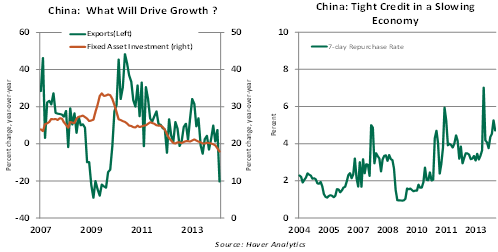
The credit-driven increase in investment following the global financial crisis led to serious excess capacity in the country. Reportedly, an industry survey by the State Council indicates that 71% of respondents noted "relatively or very serious" overcapacity in iron and steel, cement, coal, aluminum, solar panels, and ship-building industries. In an environment of excess capacity, the drive for additional investment could be weak.
Further, Chinese authorities are intent on clamping down on the growth of credit that fueled this investment boom. China’s bank assets, a proxy for total credit in the economy, grew 142% during the five years ended 2013, while real gross domestic product moved up 52% in the same period. We are seeing the early signs of adverse consequences in a string of debt defaults. Chinese authorities have sent a message that investors have to brace themselves against more defaults and understand there is risk in the marketplace.
 In this context, it is noteworthy that the People’s Bank of China (PBoC) raised the repurchase (repo) rate in the final months of 2013. Although the PBoC eased the repo rate slightly in February, the level is noticeably high compared with a below 2% mark in 2009 when China was putting in place policies to prevent likely economic stagnation.
In this context, it is noteworthy that the People’s Bank of China (PBoC) raised the repurchase (repo) rate in the final months of 2013. Although the PBoC eased the repo rate slightly in February, the level is noticeably high compared with a below 2% mark in 2009 when China was putting in place policies to prevent likely economic stagnation.
Pulling forward key public works projects such as housing, railways and urban infrastructure will stimulate demand. China has sizable reserves to finance this expansion. But finding stronger and more balanced private-sector growth remains a significant challenge.
Stress Testing: A Capital Idea
The Federal Reserve recently released the results of its annual Comprehensive Capital Analysis and Review (CCAR). The CCAR is centered on a stress test, which is an appropriate moniker; analysts at banks and the Fed work on tight deadlines with significant stakes. Following are some reflections on the exercise, from someone who has seen it from both sides.
- Among the many proposed remedies for financial excess, higher levels of bank capital may be the most effective. Specific rules and prohibitions are hard to craft, and often circumvented. If shareholders have more skin in the game, their focus on bank practices rises and the risk of financial contagion falls.
The Fed’s stress testing program has contributed to an increase in both the amount and quality of U.S. bank capital over time. Interestingly, today’s levels of capital after stress are higher than they were before stress in 2009.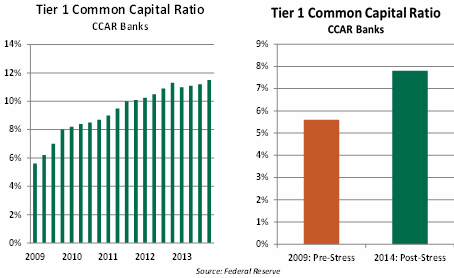
For big banks, the annual CCAR has become the most important test of their capital adequacy, superseding traditional measures. - Once again this year, several firms were found to have capital insufficient to withstand a stressful environment or systems inadequate for analyzing the consequences of severe circumstances. These firms are certainly not insolvent, but they will have to defer increases in distributions to their shareholders.
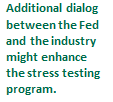 Proponents argue that the fact that firms can fall short suggests that the process is tough and objective. Some in the industry complain that the Fed’s models and review criteria are too opaque and therefore difficult to comply with. Since neither firms nor the Fed wants to see failure or financial stability, there should be common ground to find in the years ahead.
Proponents argue that the fact that firms can fall short suggests that the process is tough and objective. Some in the industry complain that the Fed’s models and review criteria are too opaque and therefore difficult to comply with. Since neither firms nor the Fed wants to see failure or financial stability, there should be common ground to find in the years ahead. - Universal, international banks continue to find it hard to do well in CCAR. Meeting the requirements of capturing all relevant exposures, creating a global scenario that tests all business lines, and demonstrating requisite board and senior management oversight are all much more difficult for the biggest firms.
Stress testing challenges may prompt these firms to think about shrinking. This would reduce the "Too Big to Fail" problem that was illustrated again this week in work from the New York Fed. - Efforts to replicate the process in other markets are seen as crucial to putting financial institutions in position to support economic growth. European authorities are currently engaged in trying to replicate the Fed’s process, hoping to replicate its favorable impact on capital and the credibility of supervisors. But are they willing to fail a big institution to send a clear message? That remains to be seen.
Recommended Content
Editors’ Picks
EUR/USD edges lower toward 1.0700 post-US PCE

EUR/USD stays under modest bearish pressure but manages to hold above 1.0700 in the American session on Friday. The US Dollar (USD) gathers strength against its rivals after the stronger-than-forecast PCE inflation data, not allowing the pair to gain traction.
GBP/USD retreats to 1.2500 on renewed USD strength

GBP/USD lost its traction and turned negative on the day near 1.2500. Following the stronger-than-expected PCE inflation readings from the US, the USD stays resilient and makes it difficult for the pair to gather recovery momentum.
Gold struggles to hold above $2,350 following US inflation

Gold turned south and declined toward $2,340, erasing a large portion of its daily gains, as the USD benefited from PCE inflation data. The benchmark 10-year US yield, however, stays in negative territory and helps XAU/USD limit its losses.
Bitcoin Weekly Forecast: BTC’s next breakout could propel it to $80,000 Premium

Bitcoin’s recent price consolidation could be nearing its end as technical indicators and on-chain metrics suggest a potential upward breakout. However, this move would not be straightforward and could punish impatient investors.
Week ahead – Hawkish risk as Fed and NFP on tap, Eurozone data eyed too

Fed meets on Wednesday as US inflation stays elevated. Will Friday’s jobs report bring relief or more angst for the markets? Eurozone flash GDP and CPI numbers in focus for the Euro.